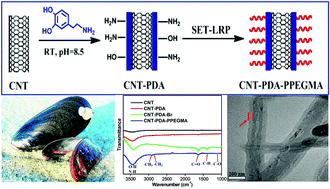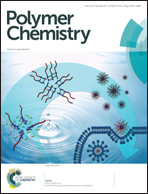Surface modification of carbon nanotubes by combination of mussel inspired chemistry and SET-LRP†
Abstract
An efficient and facile strategy was developed for the surface modification of functional carbon nanotubes (CNTs) by the combination of mussel inspired chemistry and single electron transfer living radical polymerization (SET-LRP). This method involves the dopamine (DA) formation of polydopamine (PDA), which was coated on the surface of pristine CNTs via self-polymerization in alkaline solution. Then, the Br-containing initiator was covalently attached on the surface of CNTs modified with PDA. Subsequently, the poly[poly(ethylene glycol) methyl ether methacrylate] (PPEGMA) was in situ grown on the surface of Br-containing CNTs via the SET-LRP method. The resulting functional materials were characterized by a series of characterization techniques. It was demonstrated that PPEGMA chains were successfully conjugated to the surface of CNTs via a combination of mussel inspired chemistry and SET-LRP. After modifying with PPEGMA, the functional CNTs retain their pristine structure, but their dispersibility was significantly improved in polar and nonpolar solutions. Compared with previous methods, the strategy developed in this work is rather simple and effective. More importantly, due to the universality of mussel inspired chemistry, this novel strategy could also be used for the surface modification of many other materials.


 Please wait while we load your content...
Please wait while we load your content...